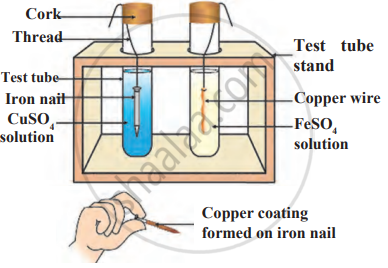Advertisements
Advertisements
Question
Give a balanced equation for the following type of reaction:
A displacement reaction in which a metal above hydrogen in the reactivity series, displaces another metal from the solution of its compound.
Solution

\[\ce{Fe + CuSO4->Cu + FeSO4}\]
APPEARS IN
RELATED QUESTIONS
How will you obtain Magnesium oxide from magnesium.
Also give balanced equations for the reactions
How will you obtain Silver chloride from silver nitrate.
Also give balanced equations for the reactions
Write chemical equation for the event.
Iron filings are dropped in aqueous solution of copper sulphate.
With reference to Acid explain with a suitable example of how the reactivity of the metals could be differentiated.
Give a balanced equation for the reversible catalytic reaction involving nitrogen as one of the reactants.
Explain the following reaction with the balanced equation.
Sulphur burns in air
Observe the following diagram and identify the type of reaction and write observation.

Which among the following statements is incorrect for magnesium metal?
Metal ‘A’ has electronic configuration 2, 8, 1 and metal ‘B’ has electronic configuration 2, 8, 8, 2. Out of these, which metal is more reactive? Write the reaction of this metal with dilute HCl acid.
Three metal samples of magnesium, aluminium and iron were taken and rubbed with sandpaper. These samples were then put separately in test tubes containing dilute hydrochloric acid. Thermometers were also suspended in each test tube so that their bulbs dipped in the acid. The rate of formation of bubbles was observed. The above activity was repeated with dilute nitric acid and the observations were recorded.
Answer the following questions:
(i) When the activity was done with dilute hydrochloric acid, then in which one of the test tubes was the rate of formation of bubbles the fastest and the thermometer showed the highest temperature?
(ii) Which metal did not react with dilute hydrochloric acid? Give reason.
(iii) Why is hydrogen gas not evolved when a metal reacts with dilute nitric acid? Name the ultimate products formed in the reaction.
OR
Name the type of reaction on the basis of which the reactivity of metals is decided. You have two metals X and Y. How would you decide which is more reactive than the other?
